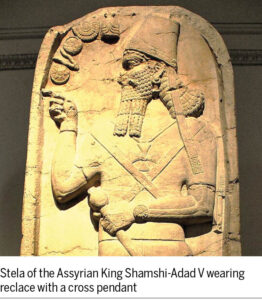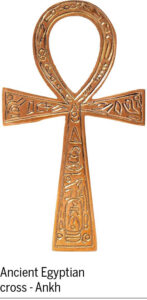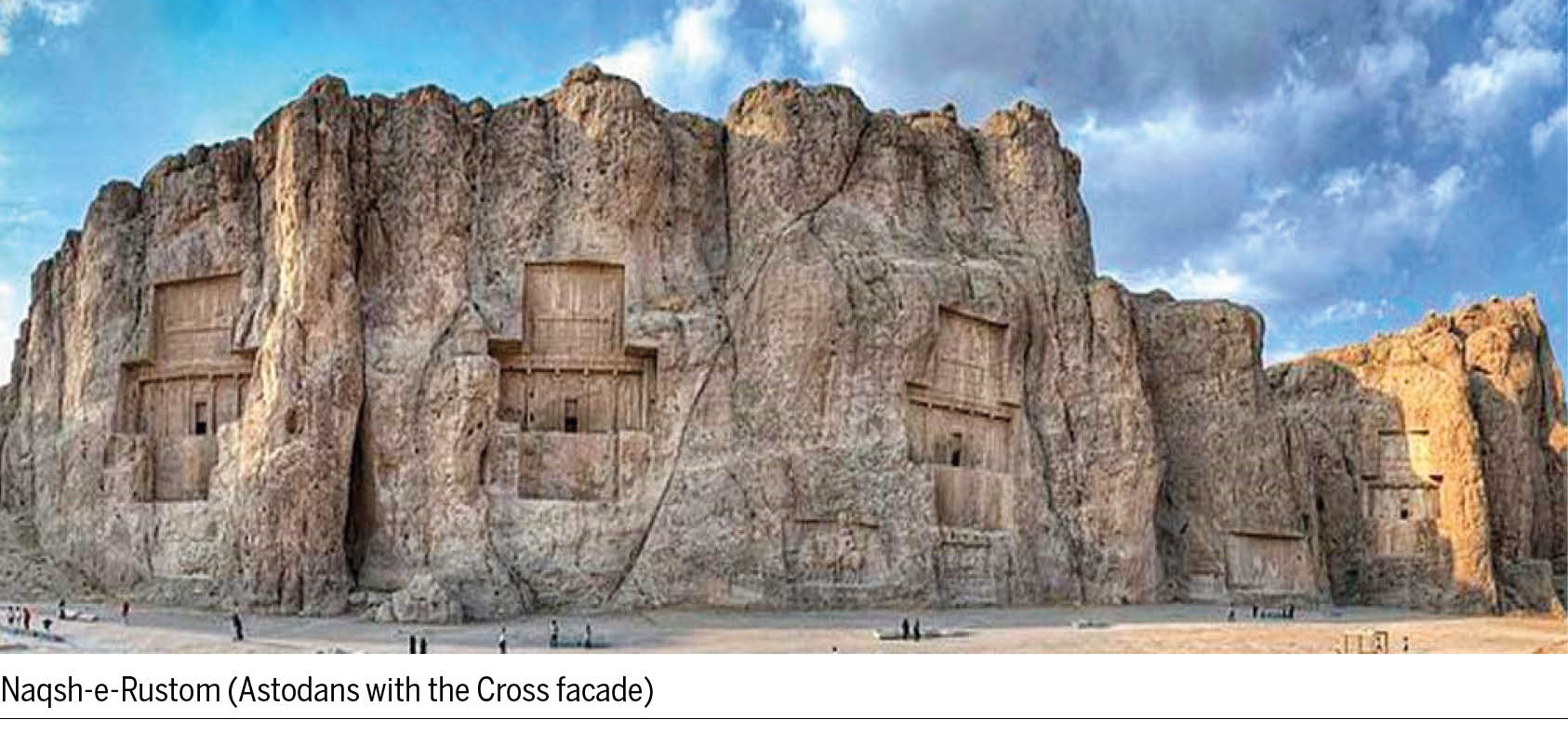 The Cross Necropolis of Iran is Naqsh-e-Rustam. Another local name by which Naqsh-e-Rustam is known is ‘Salib’ (Arabic for cross). This ancient historical site in Fars province, Southern Iran, features four tombs of Achaemenid kings. The rock-cut tombs (Astodan), hewn into a cliff face, are believed to belong to Darius the Great and his successors, including Xerxes the Great, Artaxerxes I and Darius II. These imposing tombs were created around 486 – 424 BC and are marked by ornate facades and inscriptions in old Persian cuneiform. The question often arises why the Christian symbol of the cross is embellished on the façade of the tombs of Persian kings, almost five centuries before the birth of Jesus Christ?
The Cross Necropolis of Iran is Naqsh-e-Rustam. Another local name by which Naqsh-e-Rustam is known is ‘Salib’ (Arabic for cross). This ancient historical site in Fars province, Southern Iran, features four tombs of Achaemenid kings. The rock-cut tombs (Astodan), hewn into a cliff face, are believed to belong to Darius the Great and his successors, including Xerxes the Great, Artaxerxes I and Darius II. These imposing tombs were created around 486 – 424 BC and are marked by ornate facades and inscriptions in old Persian cuneiform. The question often arises why the Christian symbol of the cross is embellished on the façade of the tombs of Persian kings, almost five centuries before the birth of Jesus Christ?
Ancient Mesopotamian And Egyptian Cross
Many people regard the cross as a symbol of Christianity. However, cross forms were used as symbols long before the Christian Era. The cross symbol in ancient Mesopotamia was often associated with religious and astronomical symbolism and appears in quite a few Sumerian and Babylonian reliefs. The Stela of the Assyrian king Shamshi-Adad V (824 BC – 811 BC) from the temple of Nabu at Nimrud, Mesopotamia, depicts the king wearing a pendant in a necklace that is in the form of a cross. In other words, the cross was worn as either a charm or ornament in Mesopotamia (modern Iraq) more than eight centuries before the birth of Jesus Christ.
Crux Ansata is a cross surmounted by a loop and happens to be the ancient Egyptian hieroglyphic symbol of eternal life known as Ankh. The Ankh was first used in ancient Egypt (3150 – 2613 BC) and believed to represent the cohesion of heaven and earth. The Achaemenian kings were deeply influenced by both, Mesopotamian and Egyptian culture and it could be postulated that the cross embellished on the façade of the tombs symbolised the Great kings having attained eternal life! However, a more plausible theory could be that this was the Chalipa – The Persian or Aryan Cross.
 Cross As Symbol Of Christianity
Cross As Symbol Of Christianity
Christians began using the cross as a symbol in the second century AD. It became a prominent symbol of Christianity only in the 4th century AD after Emperor Constantine converted to Christianity and promoted its religious importance. The early depictions of the crucifixion were empty crosses, and the crucifix with Jesus on it did not appear until the sixth century AD. The term crucifix is derived from the Latin cruci fixus meaning ‘one fixed to a cross.’ Thus, the cross reminds devotees about the crucifixion of Jesus Christ and the redeeming benefits of His passion and death. The cross is thus a sign, both of Christ himself and of the faith of Christians. In ceremonial usage, making a sign of the cross may be, according to the context, an act of profession of faith, a prayer, a dedication, or a benediction.
Before the time of Emperor Constantine in the fourth century, Christians were reticent about portraying the cross because too open a display could have put them in danger. Christians were persecuted in Rome mainly due to their refusal to worship the Gods of Rome. However, after Emperor Constantine of Rome converted to Christianity, he abolished crucifixion as a death penalty and promoted the cross as a symbol of Christian faith.
History Of Crucifixion
Crucifixion was likely invented by the Assyrians and Babylonians, and was used by the Persians as early as the sixth century BC. Crucifixion was most frequently used to punish political or religious agitators, pirates, slaves, or those who had no civil rights. The first written record of people being crucified is left to us by the Greek historian, Herodotus who in ‘The Histories’ wrote that the Achaemenid king Darius I of Persia ordered the crucifixion of three thousand of the leading citizens of Babylon in about 519 BCE. Also, in the famous Behistun inscription, Darius declares: “Then I made a decree, saying: ‘Let that Arakha (Nebuchadnezzar) and the men who were his chief followers be crucified in Babylon!”
Crucifixion was also used by the Carthaginians to punish enemies and deserters, as also by Alexander the Great. The Roman senator, Quintus Curtius Rufus, wrote that Alexander ordered two thousand citizens of the Tyre crucified after his conquest of the city in 332 BC. In the spring of 30 AD (some scholars say it was 33 AD) Pontius Pilate had Jesus of Nazareth put to death by crucifixion.
Crux (Cross) Constellation
Crux is a constellation of the southern sky that is centred on four bright stars in a cross-shaped pattern commonly known as the Southern Cross. It lies on the southern end of the Milky Way’s visible band. The name Crux is Latin for cross. Despite being the smallest of all eighty-eight modern constellations, Crux is among the most easily distinguished as its four main stars each have visually bright magnitude. It has attained a high level of cultural significance in many Southern Hemisphere states and nations.
In Christmas lore, the star in the east, followed by the three wise men, Sirius, is the brightest star in the night sky, which, on 24th December, aligns with the three brightest stars in Orion’s belt. These three bright stars in Orion’s belt were earlier called, ‘The Three Kings’ (later the three wise men). The three kings and the brightest star, Sirius, all point to the place of the sunrise on 25th December. This is why the three kings followed the star in the east to locate the sunrise or the birth of the sun in the sky.
The winter solstice is the longest, darkest night in the Northern hemisphere. The sun, having moved south, continually for six months, makes it to its lowest point in the sky and here, a curious phenomenon is observed. The sun stops moving south at least perceivably for three days and during this three-day pause, the sun resides in the vicinity of the Southern Cross, or Crux constellation. After this time, on 25th December, the sun starts to move north, promising longer days, warmth, and spring.
Is it a coincidence that in the Sky, the Sun seemingly dies on the Crux Constellation (Crux means Cross), seems dead for three days and is born again and on Earth the Son (of God) dies on the cross, seems dead for three days but is resurrected or born again. Indeed, as above, so below!
(Watch this space for the conclusive part next week)
- Celebrating Women And Equality - 8 March2025
- How The Greeks Viewed Ancient Persians - 1 March2025
- Moon And Moods - 22 February2025
